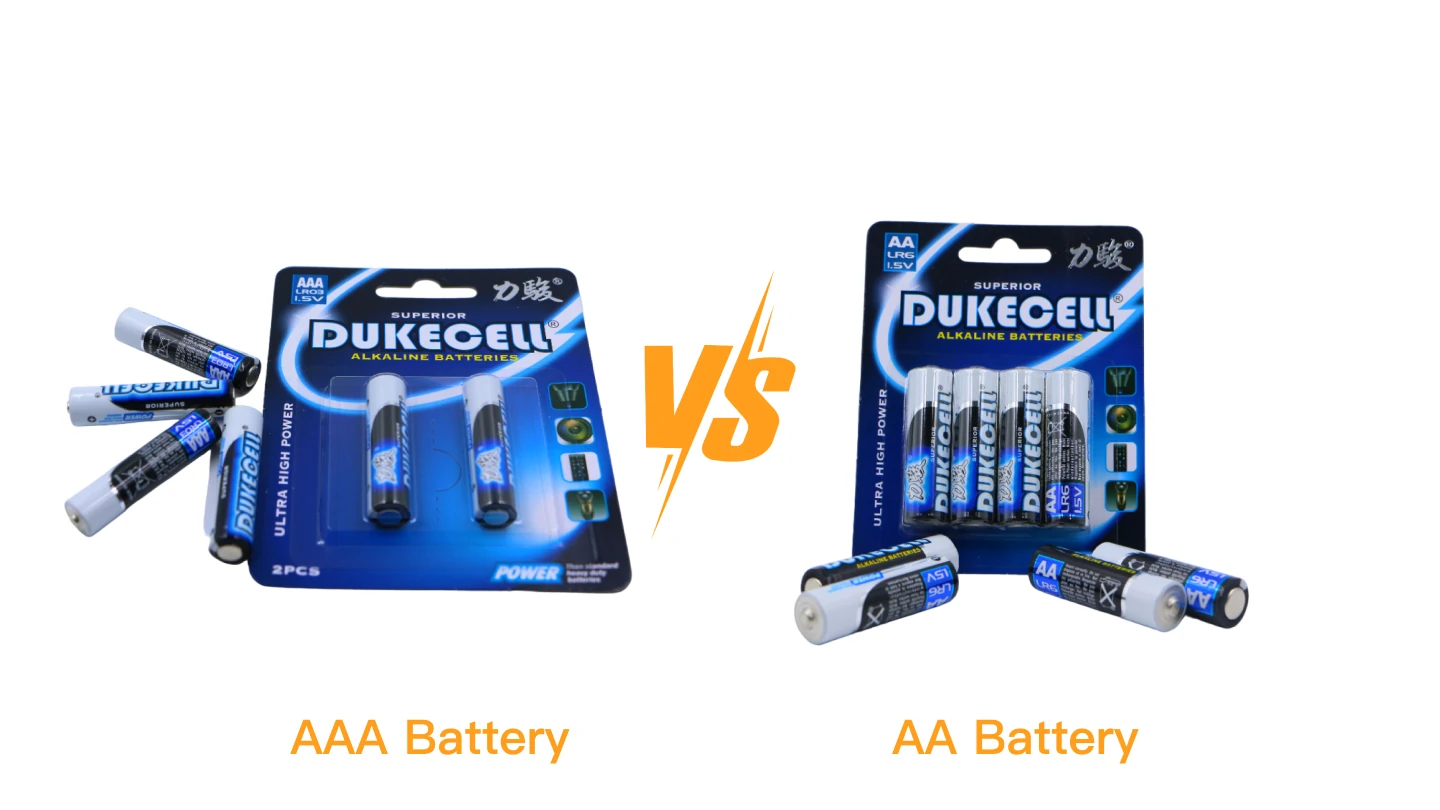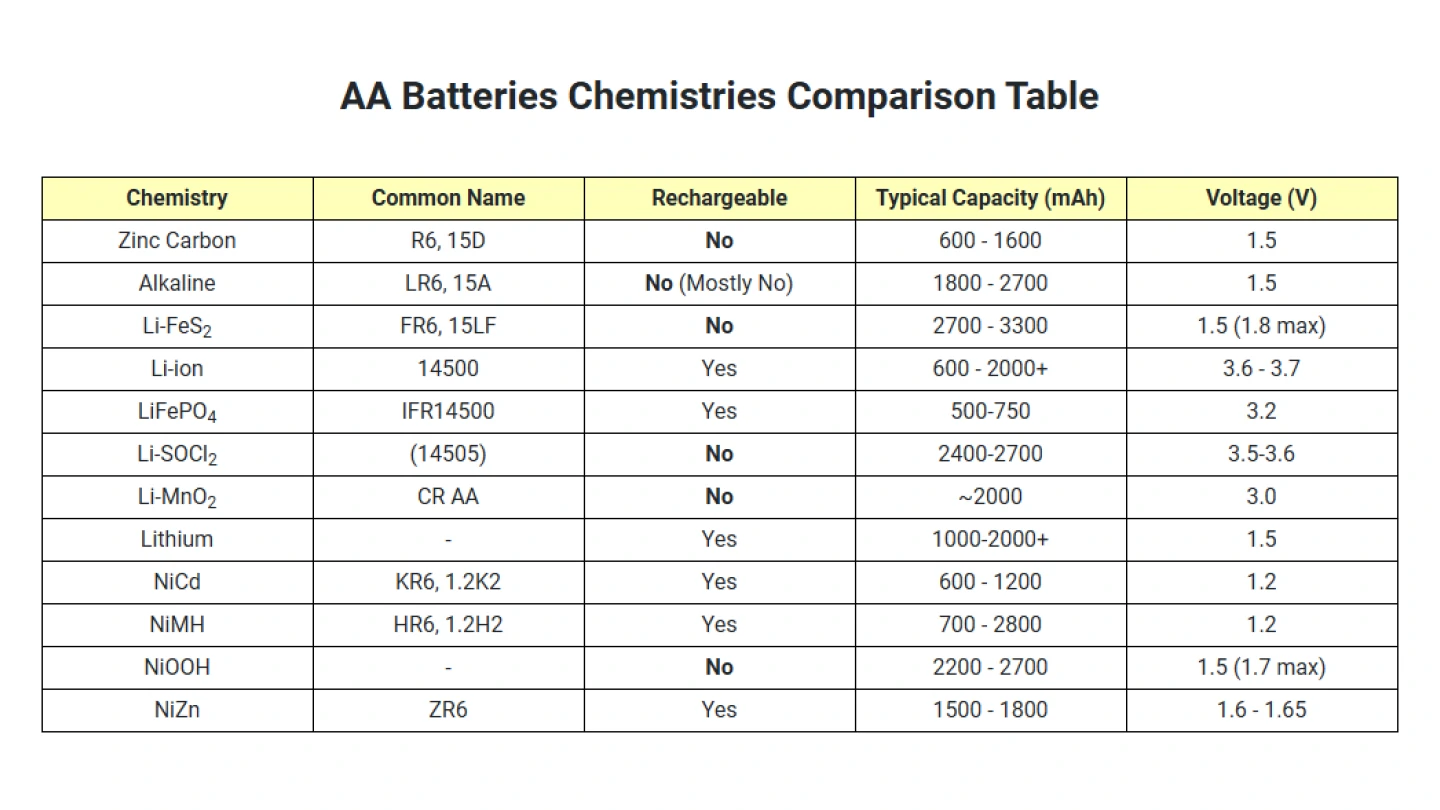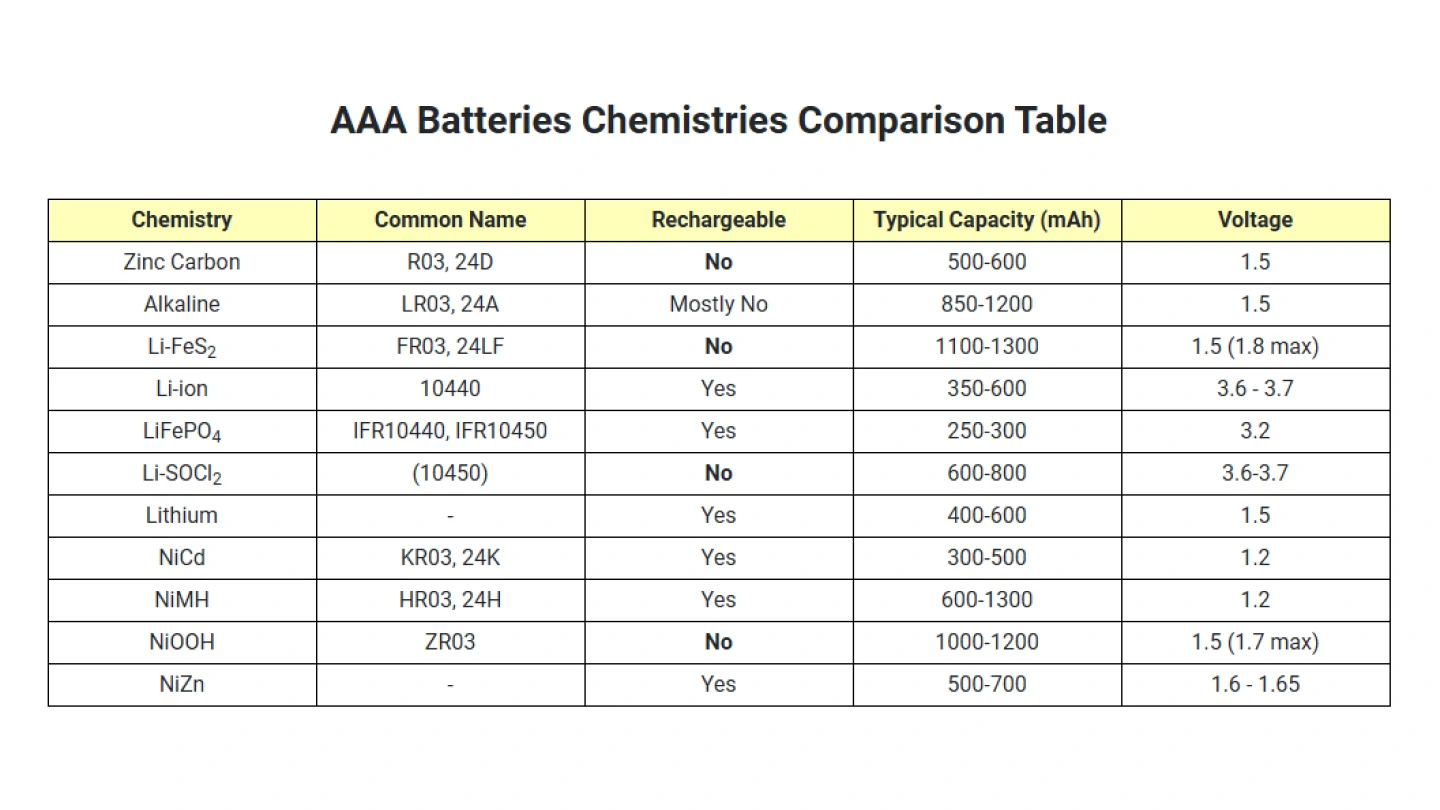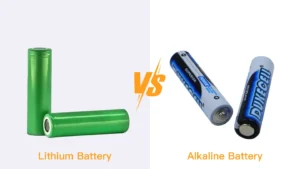When powering devices, the most common battery sizes are AA and AAA. These batteries can be used in a variety of products ranging from remote controls to toys, flashlights, and more. But how do you know which one is suitable for your needs? Let’s explore the differences between AA and AAA batteries to help you make an informed decision based on specific requirements.

The difference between AA and AAA batteries
The distinction between AA and AAA batteries lies primarily in their size, capacity, and common applications. AA batteries are larger, with a diameter of about 14.2 mm and a height of approximately 50.5 mm, making them suitable for devices that demand more power, such as digital cameras and portable speakers. AAA batteries, being smaller with a diameter of around 10.5 mm and a height of about 44.5 mm, are ideal for devices that require a more compact power source, like flashlights and MP3 players.
Additionally, due to their larger size, AA batteries typically have a greater capacity and can last longer compared to AAA batteries. Despite their similarities in voltage, both batteries, which are 1.5 volts, are not interchangeable in devices due to these differences. Consumers must consider the battery requirements of their devices to ensure compatibility and optimal performance.
For historical reasons, AA and AAA batteries feature a nominal voltage of 1.5 volts, the voltage of the first Zinc-Carbon AA batteries, practically the oldest AA and AAA battery types.
The following comparison tables list some of the most popular AA and AAA battery chemistries, with their most important features and specifications.

AA Batteries Chemistries Comparison Table

AAA Batteries Chemistries Comparison Table
What Is AA Battery?
The AA battery (also known as R6) is one of the battery models, typically characterized by a diameter of 14 mm and a height of 50 mm. Due to its small size and moderate electric capacity, the AA battery is widely used in a variety of household appliances and digital electronic products. The AA batteries available on the market include nickel metal hydride nihm rechargeable batteries, nickel cadmium rechargeable aa batteries, alkaline zinc-manganese batteries (commonly referred to as “dry cell batteries”), and common acidic zinc-manganese batteries (commonly referred to as “traditional batteries”). You can understand the basic performance of the AA battery by looking at the English letters marked on the battery, which helps to determine what kind of battery to use in what device.
AA Batteries: These batteries are larger in size and typically have a greater capacity, which means they can provide power for a longer duration.
The American National Standards Institute (ANSI) has officially standardized the dimensions of AA batteries as follows:
The height or length of the AA casing shall be a minimum of 49.2 mm and a maximum of 50.5 mm.
The diameter of the AA casing shall be a minimum of 13.5 mm and a maximum of 14.5 mm.
In addition to these two dimensions, there are two other important dimensions for AA batteries: the height and diameter of the positive terminal, and the diameter of the negative terminal.
The height of the positive terminal must be at least 1 millimeter, and its diameter can be up to a maximum of 5.5 millimeters. For the flat negative terminal, the diameter must be at least 7 millimeters.
Read more: what is aa battery?
What Is AAA Battery?
The AAA battery is a standard for dry batteries in the United States, compatible with the model number for batteries in China or Taiwan. The battery is cylindrical, 43.6 mm in height and 10.1 mm in diameter. It is a common battery, smaller than the AA battery. It is commonly used in small-sized electronic devices that consume less power, such as MP3 players, small smart remote controls, tv remote etc. There are disposable dry batteries, as well as rechargeable nickel metal hydride nihm and lithium batteries.
AAA Batteries: These batteries are smaller in size and are well-suited for compact devices that require less power.
AAA batteries are also cylindrical in shape. However, the height (or length) and diameter of AAA batteries are smaller than those of AA batteries. According to the ANSI standards, the following are the dimensions for AAA batteries.
The height or length of the AAA casing shall be a minimum of 43.3 mm and a maximum of 44.5 mm.
The diameter of the AAA casing shall be a minimum of 9.5 mm and a maximum of 10.5 mm.
The minimum height of the positive terminal must be 0.8 mm, with a maximum diameter of 3.8 mm. The minimum diameter for the flat negative terminal is 4.3 millimeters.
Similar to AA batteries, AAA batteries also come in two types: primary (non-rechargeable) and secondary (rechargeable).
Read more: what is aaa battery?
The Difference Between AA And AAA Batteries:
1. AA is commonly referred to as the model for these batteries, typically with size specifications of: 14 mm in diameter and 49 mm in height.
2. AAA is commonly referred to as the model for these batteries, typically with size specifications of: 11 mm in diameter and 44 mm in height.
3. The size of the AA battery and the AAA battery is different. The typical size specifications for the AA battery are 14 mm in diameter and 49 mm in height. The AAA battery is slightly smaller than the AA battery, with size specifications of 11 mm in diameter and 44 mm in height. People can easily see the big difference between the two from the appearance of the battery.
Size Specifications For AA And AAA Batteries:
1. The AAA battery model is relatively common, typically used in MP3s, with a standard AAA battery height of 43.6±0.5mm and a diameter of 10.1±0.2mm.
2. The AA battery model is even more obvious, used in digital camcorders, electric toy cars, tv remote etc., with a standard AA battery height of 48.0±0.5mm and a diameter of 14.1±0.2mm.
Scope Of Application For AA And AAA Batteries:
The AAA battery is a common battery, smaller than the AA battery. It is commonly used in small-sized electronic devices with low power consumption, such as MP3 players, small smart remote controls, etc. There are disposable dry batteries, as well as rechargeable nickel-metal hydride and lithium batteries.
AA Batteries: High-power devices: Digital cameras, portable radios, and gaming controllers. Medium-power devices: Wall clocks, LED flashlights, and toys.
Why choose AA? When you need a power source with longer life or to power devices that consume more energy, choose AA batteries.
AAA Batteries: Low-power devices: TV remote controls, wireless computer mice, and small portable devices.
Why choose AAA? For small devices with limited space and low power requirements, choose AAA batteries.
AAA Batteries Vs AA Batteries
In the battery market, aaa batteries and aa batteries are two very common types of batteries, differing in size, capacity, and application scenarios. Aaa batteries, also known as size 7 batteries, are typically smaller than aa batteries (size 5 batteries), yet both have a voltage of 1.5 volts. However, due to the difference in volume, the energy density of aaa batteries is usually lower than that of aa batteries, which means that under the same conditions, aa batteries can provide more enduring power.
When choosing batteries, consumers often face the aaa batteries vs aa batteries. Due to their smaller size, aaa batteries are more suitable for small electronic devices such as remote controls, flashlights, and some portable gaming consoles. On the other hand, aa batteries, with their larger capacity, are more suitable for devices that require more power, such as wireless mice, alarm clocks, and some handheld gaming consoles.
In terms of environmental protection and cost-effectiveness, aaa batteries vs aa batteries also differ. Because aaa batteries are smaller in volume, they may use less material in the production process, which could have a smaller environmental impact. However, due to the higher energy density of aa batteries, they may be more cost-effective in the long run, as they can provide a longer usage time, thereby reducing the frequency of battery replacement.
Overall, aaa batteries vs aa batteries each have their own advantages and appropriate scenarios. When making a choice, users should consider the battery requirements of the device, the environmental impact of the batteries, and the cost-effectiveness of long-term use. Whether it’s aaa batteries or aa batteries, understanding their performance differences is crucial for making a wise choice.
AAA vs AA: Comparison of Battery Size and Performance
In daily life, batteries are an indispensable source of energy for many portable electronic devices. Among the many battery sizes, AAA and AA batteries are two of the most common dimensions. So, in the “AAA vs AA” comparison, how should we choose based on their characteristics?
Firstly, in terms of size, AAA batteries are smaller than AA batteries. AAA batteries have a diameter of about 10.5 mm and a height of about 49.5 mm, while AA batteries also have a diameter of about 10.5 mm but are slightly taller at about 50 mm. Although both have the same diameter, AA batteries are slightly taller than AAA batteries, which means that AA batteries generally have a larger volume and capacity.
In the “AAA vs AA” performance comparison, due to their larger size, AA batteries can typically hold more power, thus often outperforming AAA batteries in terms of endurance. However, because of their smaller size, AAA batteries are also lighter in weight, making them more suitable for devices that require lightweight design.
Furthermore, in terms of price, there is a difference between “AAA vs AA” as well. Due to differences in manufacturing costs and battery capacity, AA batteries are usually priced slightly lower than the same quantity of AAA batteries. This is not because AA batteries perform better than AAA batteries, but because the production scale of AA batteries is generally larger, which reduces the unit cost.
In the choice between “AAA vs AA,” there is no absolute superiority or inferiority; it is more about deciding based on specific needs. If a device requires a longer usage time and greater power, AA batteries may be the better option. For devices that pursue lightweight and compact design, AAA batteries might be more suitable. Regardless of which type of battery is chosen, considerations should include the battery’s endurance, price, and device compatibility to ensure the best user experience.
Conclusion
The choice between AA and AAA batteries depends on your specific needs:
If you need to provide longer-lasting power for high-power or medium-power devices, choose AA batteries. If you are powering small, low-power devices and require a more compact battery size, choose AAA batteries.




